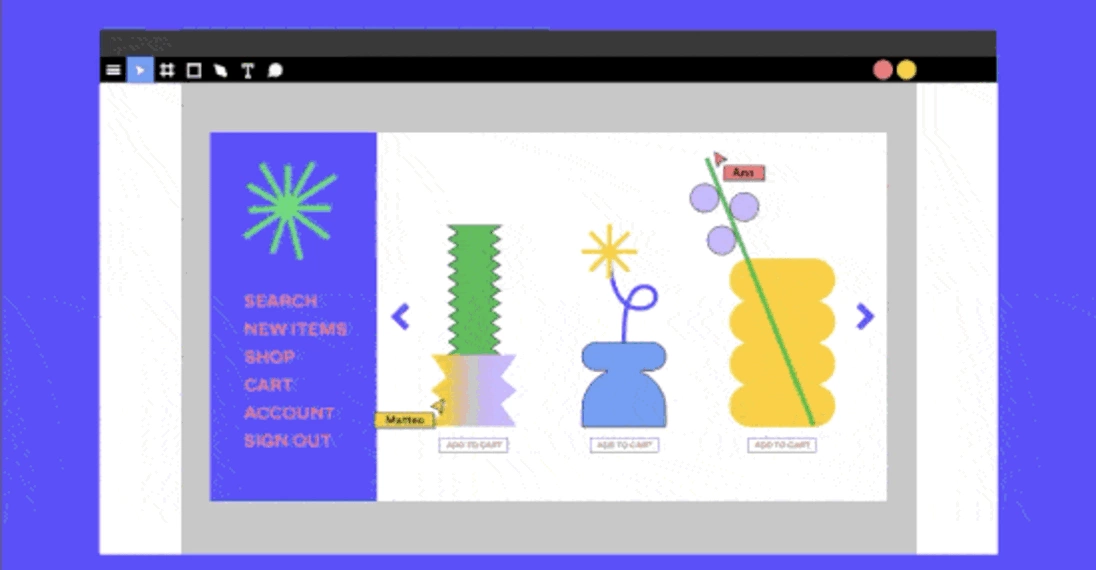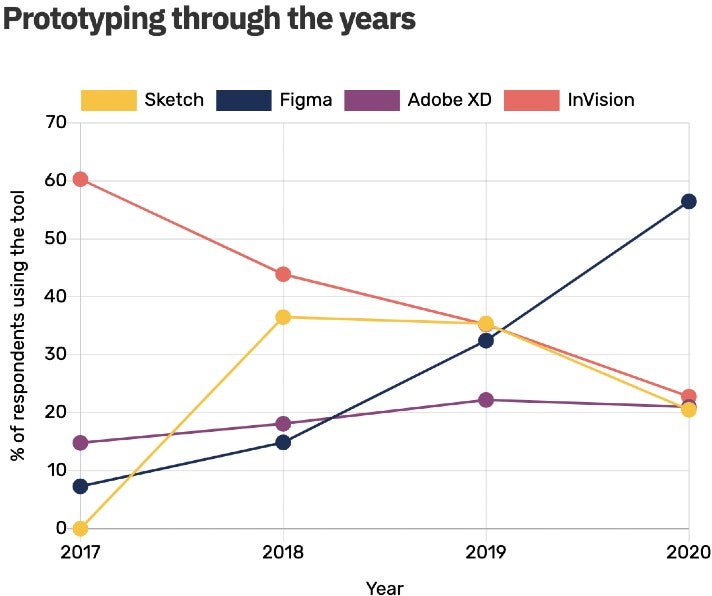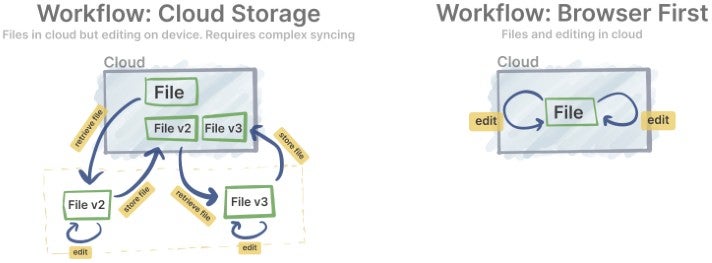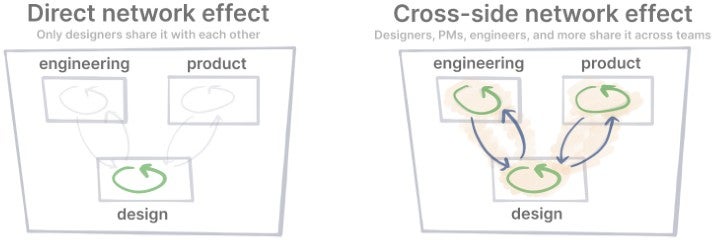Figma: With "Product Led Growth", Content and Community to the Enterprise Software Decacorn
How the design software has successfully shaken up the tech industry

It is probably rare for a B2B enterprise software to evoke enthusiasm among its users, let alone generate a hype. However, the design tool Figma seems to have achieved exactly this in the past two years. Figma users rave about the tool in glowing terms, companies like Airbnb, Dropbox, Google, Microsoft, Uber and Spotify use Figma to design their user interfaces, and the company behind the software is now reputedly worth more than ten billion U.S. dollars. OMR shows how Figma has driven its own growth story through the perfect intertwining of product and marketing.
"Outstanding." - "For sure one of the most innovative design tools currently on the market." - "The performance in comparison to overloaded classic design tools is amazing." - "The range of features still impresses me even after about 3 years of using Figma." - These are not advertising texts from the Figma website, but extracts from reviews of the tool on OMR Reviews.
Quickly surpassed the competition
It is clear that the creators of the tool have managed to fulfill a need. Figma is designed for designing digital products and user interfaces together in a team. The tool doesn't need to be installed on the computer, but works purely browser-based and in real time.
And it does this very well: not only is the OMR Reviews community convinced by Figma. Both a comparison using Google Trends, and a survey of over 4,000 designers conducted by the site UXTools.co, show that Figma has apparently overtaken competitors such as Invision and Sketch within a few years.

Figma has overtaken the three major competitors in prototyping tools last year (Source: 2020 Design Tools Survey by UXTools.co)
The Who's Who of VCs have invested
This success is reflected in the company's figures: by April 2020, Figma is reported to have registered four million users. The startup allegedly turned over 75 million U.S. dollars in 2020; this year, Figma expects to double this, as Forbes recently reported. Figma just announced in June the latest of a total of six funding rounds. The company has so far raised just under 333 million, according to Crunchbase. The investors include the most renowned VC firms in Silicon Valley: Andreessen Horowitz, Greylock, Index, Kleiner Perkins Caulfield Byers and Sequoia. According to Bloomberg Figma's valuation is now said to be over ten billion U.S. dollars.
However, this success was not foreseeable for a long time. Although the two founders Dylan Field and Evan Wallace are "high potentials": Both met at the elite university Brown in Providence, Rhode Island; Field received a scholarship from celebrity investor Peter Thiel (and dropped out of university for this). Yet the two's initial attempts as entrepreneurs were rocky (here a worthwhile Twitter thread about the early days). After initially wanting to program software for drones, they switched to the idea of programming the "Photoshop for the browser". For several years, Field and Wallace had no real finished product on the market; apparently, both had over-committed themselves and wanted to develop and offer too many tools at once. It was only the focus on collaborative design of interfaces that brought success. And since then, this success has known no end.
Success factor 1: "Product Led Growth"
The central reason for Figma's rise is certainly the product itself - because it makes the lives of its users easier. The process of how designers, developers and other departments of companies work together has long been extremely cumbersome. Kevin Kwok writes that he observed designers in startups at work in 2014 in a readable analysis of Figma's success. At the time, Kwok was working for the VC firm Greylock Ventures and was involved in the "Due Diligence" for Figma (Greylock invested in the company as part of the Series A round). "On the designers' monitors, I saw a never-ending stream of Dropbox notifications in the top right corner. Because design teams used services like Dropbox to store all their files in shared folders, they would receive a notification with every change made by a colleague. Plus, there were complex naming guidelines for files to ensure that everyone had access to the right version of the file."

Figma simplifies workflows (graphic source: Kevin Kwok)
With Figma, there are not multiple files, but only one project. All those involved in the process access the same project via the browser, can edit and comment on it in real time. New software technology like Web GL apparently makes it possible for this to work quickly and relatively reliably. He had been skeptical about Figma's web-based platform, product designer Andrey Sundiev wrote in November 2019 in the company blog of his then employer Intercom. But the software even worked when he tested it on the beach, solely connected via his mobile phone's hotspot. Such a positive product experience results in many referrals - the VC firm Openview Partners, which invests in software companies, has coined the term "Product Led Growth".
Success factor 2: The Freemium model
The fact that with Figma everyone involved (not just the design team) can access the same project not only simplifies the handover from designers to developers. But this also results in propagation effects for Figma - Kevin Kwok speaks of "Cross-side Network Effects" here. Figma is also being adapted by other teams within the company.

Illustration of the "Cross-side Network Effects" of Figma by Kevin Kwok
This development is additionally favored by the fact that Figma uses a freemium pricing model (with which many other software companies - like Mailchimp for example - have celebrated successes): All "viewers, who only look at a project", can use the software for free. For smaller projects, the use of the design tool is also free. This lowers entry barriers and allows potential users to gain trust more easily and quickly.
Success factor 3: Local Ambassadors & Events
To further develop the product and fuel its spread, the Figma team has been in close exchange with the users from the beginning, reports Claire Butler, who has been responsible for Figma's marketing since its inception, in a 2018 podcast. Users have been able to give direct feedback from the beginning via a chat box in the right corner of the screen. There is now also a user forum where members can request new features. Claire Butler: "We have spoken to users every day. This helped us a lot in the beginning. Now we have a user forum, where users can request new features." The input generated in this way would be reacted to not only by customer support, but also by developers and the design team.
To further enhance word-of-mouth effects, the Figma team began hosting meetups around the world in early 2018. First in six cities, a few months later in over 20 locations around the globe - not only in the USA, but also in Europe, Asia and Africa. The creators of Figma rely on cooperation with local ambassadors who can apply to join a "Design Advocate" team. "That's how designers work. I don't think they would have trusted us if we had run big advertising campaigns," says Claire Butler. Many designers learn from others who are a bit more experienced than themselves. "So Figma spread through people who loved the tool, benefitted from it and then shared it with their network." Today, 80 percent of Figma's revenue is supposedly generated outside the USA.
Success factor 4: Content & Community
"One of the things we want to achieve with Figma is to build a worldwide designer community," says Figma co-founder and CEO Dylan Field in 2019 in the 20 Minute VC podcast. "If you want to learn more about design, get better at it and discuss design topics - where would you do that? At the moment probably on Twitter. But I think this could be done much better - and that is what we want to achieve with Figma."
The company provides on its website and on its YouTube channel content not only for interested people to learn design. They have given the Figma Community since October 2019 a digital home as well. Here, users can share templates and meanwhile also projects with each other. Already since August 2019 external developers and designers can also program plugins for Figma and now make them available through the community.
Will Figma soon cover the entire product development?
How can Figma grow further? Apparently, the company wants to map parts of the processes that take place before (and possibly after) the concrete design process in the future. In April this year, the company launched Figjam, a whiteboard and brainstorming tool.
At a time when more and more parts of value chains and processes are being digitalized, there seems to be room for the company to grow organically. "The entire economy is switching from physical to digital, and design is just the latest part of this development," says co-founder and CEO Dylan Field recently to Forbes. "And design is a team sport - it's collaborative by nature."

